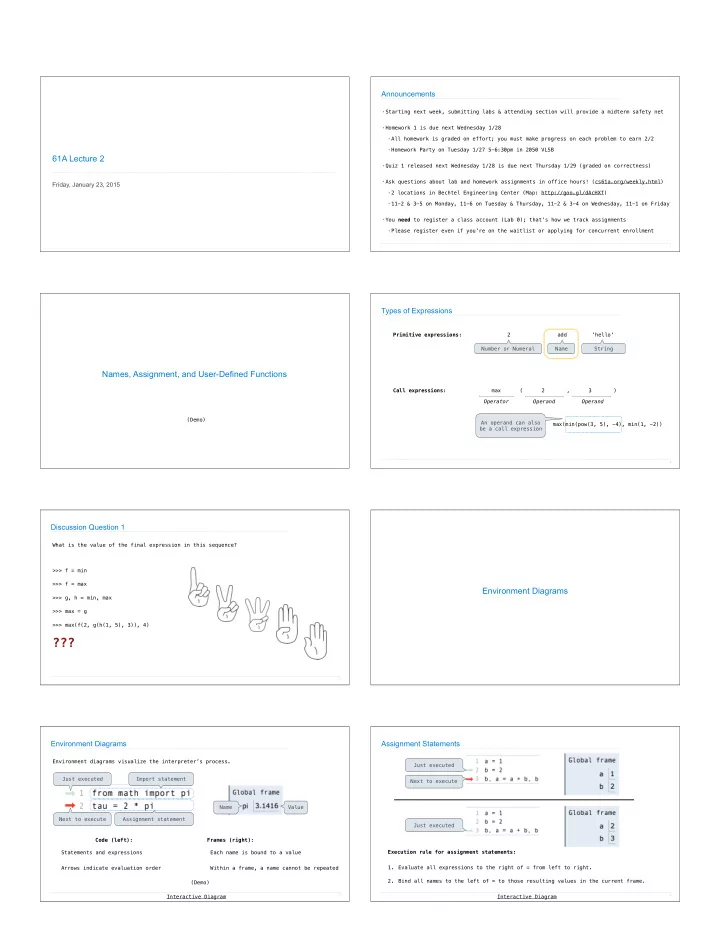

Announcements • Starting next week, submitting labs & attending section will provide a midterm safety net • Homework 1 is due next Wednesday 1/28 § All homework is graded on effort; you must make progress on each problem to earn 2/2 § Homework Party on Tuesday 1/27 5-6:30pm in 2050 VLSB 61A Lecture 2 • Quiz 1 released next Wednesday 1/28 is due next Thursday 1/29 (graded on correctness) • Ask questions about lab and homework assignments in office hours! (cs61a.org/weekly.html) Friday, January 23, 2015 § 2 locations in Bechtel Engineering Center (Map: http://goo.gl/dAcHXf) § 11-2 & 3-5 on Monday, 11-6 on Tuesday & Thursday, 11-2 & 3-4 on Wednesday, 11-1 on Friday • You need to register a class account (Lab 0); that's how we track assignments § Please register even if you're on the waitlist or applying for concurrent enrollment 2 Types of Expressions Primitive expressions: 2 add 'hello' Number or Numeral Name String Names, Assignment, and User-Defined Functions Call expressions: max ( 2 , 3 ) Operator Operand Operand (Demo) An operand can also max(min(pow(3, 5), -4), min(1, -2)) be a call expression 4 Discussion Question 1 What is the value of the final expression in this sequence? >>> f = min >>> f = max Environment Diagrams >>> g, h = min, max >>> max = g >>> max(f(2, g(h(1, 5), 3)), 4) ??? 5 Environment Diagrams Assignment Statements Environment diagrams visualize the interpreter’s process. Just executed Just executed Import statement Next to execute Name Value Next to execute Assignment statement Just executed Code (left): Frames (right): Statements and expressions Each name is bound to a value Execution rule for assignment statements: 1. Evaluate all expressions to the right of = from left to right. Arrows indicate evaluation order Within a frame, a name cannot be repeated 2. Bind all names to the left of = to those resulting values in the current frame. (Demo) Interactive Diagram 7 Interactive Diagram 8
Discussion Question 1 Solution (Demo) 3 Defining Functions func min(...) 3 4 f(2, g(h(1, 5), 3)) 3 func max(...) 2 3 g(h(1, 5), 3) func min(...) 5 3 h(1, 5) func max(...) 1 5 Interactive Diagram 9 Defining Functions Calling User-Defined Functions Procedure for calling/applying user-defined functions (version 1): Assignment is a simple means of abstraction: binds names to values 1. Add a local frame, forming a new environment Function definition is a more powerful means of abstraction: binds names to expressions 2. Bind the function's formal parameters to its arguments in that frame 3. Execute the body of the function in that new environment Function signature indicates how many arguments a function takes Built-in function >>> def <name> ( <formal parameters> ): return <return expression> Original name of function called Function body defines the computation performed when the function is applied User-defined Execution procedure for def statements: Local frame function 1. Create a function with signature <name> ( <formal parameters> ) Formal parameter 2. Set the body of that function to be everything indented after the first line bound to argument Return value (not a binding!) 3. Bind <name> to that function in the current frame 11 Interactive Diagram 12 Calling User-Defined Functions Looking Up Names In Environments Procedure for calling/applying user-defined functions (version 1): Every expression is evaluated in the context of an environment. 1. Add a local frame, forming a new environment So far, the current environment is either: 2. Bind the function's formal parameters to its arguments in that frame • The global frame alone, or 3. Execute the body of the function in that new environment • A local frame, followed by the global frame. Most important two things I’ll say all day: An environment is a sequence of frames. A name evaluates to the value bound to that name in the earliest frame of the current environment in which that name is found. E.g., to look up some name in the body of the square function: • Look for that name in the local frame. A function’s signature has all the • If not found, look for it in the global frame. information needed to create a local frame (Built-in names like “max” are in the global frame too, but we don’t draw them in environment diagrams.) (Demo) Interactive Diagram 13 14 None Indicates that Nothing is Returned The special value None represents nothing in Python A function that does not explicitly return a value will return None Careful : None is not displayed by the interpreter as the value of an expression Print and None >>> def does_not_square(x): ... x * x No return ... >>> does_not_square(4) None value is not displayed (Demo) The name sixteen >>> sixteen = does_not_square(4) is now bound to >>> sixteen + 4 the value None Traceback (most recent call last): File "<stdin>", line 1, in <module> TypeError: unsupported operand type(s) for +: 'NoneType' and 'int' 16
Pure Functions & Non-Pure Functions Nested Expressions with Print None, None print(...): Return value Does not get Pure Functions None -2 abs displayed just return values 2 Argument display “None None” None print(print(1), print(2)) 2, 100 pow 1267650600228229401496703205376 2 Arguments func print(...) None None print(1) print(2) Returns None! Non-Pure Functions -2 print have side effects None func print(...) 1 func print(...) 2 A side effect isn't a value; it's anything 2 print(...): 1 print(...): that happens as a Python displays the output “-2” None None consequence of calling a function display “2” display “1” 17 18
Recommend
More recommend